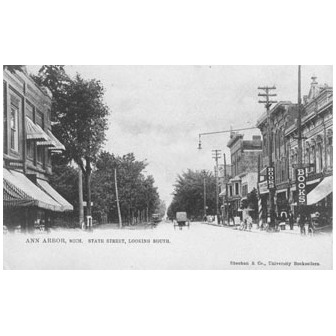State Street





In 20th century, State Street's shops began selling more luxurious goods, which attracted shoppers from beyond the immediate area. Foster's House of Art (213-215 S. State), 1914-1941, offered elegant items from around the world. Nickel's Arcade, which began construction in 1915, gave the street a European flavor and also offered specialty items. Their original line up of stores included Bays Jewelry, Caravan Gifts, and a flower shop.
State Street merchants now found a market for their goods from people drawn to the area by attendance at schools, churches, and cultural events. When University Hall was built (behind what is now Angell Hall) in 1871, just down the street from the shopping area, it included an auditorium that seated 3,000 and hosted both local and touring events such as musical performances and debates. It was here that the famous yearly musical event, the May Festival, was first presented. Ralph Waldo Emerson, Henry Ward Beecher, and Mark Twain all gave lectures on the stage of that auditorium.. The Student Christian Association (now the Kelsey Museum) had a stage on the second floor where musical performances also took place.
In the 20th century more performance venues opened nearby: Hill Auditorium (1913), Lydia Mendelssohn Theater (1929), Rackham 1938), and the Power Center (1971). The Music School, not part of U-M until 1929, was located just a block away at 325 Maynard.
Movies were another type of entertainment that appealed to both town and gown. In 1907 a nickelodeon, the People's Popular Family Theater, renamed the Vaudette, opened at 220 S. State (now Starbucks). The same year the Majestic opened at 316 Maynard (now a parking structure). Originally a legitimate theater that sometimes showed movies, it became instead, a movie theater that occasionally hosted live events. The Arcade Theater, 715 North University, showed second-run movies. In 1928 the Michigan Theater opened as a silent movie palace but soon switched to talkies. The State Theater was built during World War II to take the place of the Majestic.
Churches were also a big draw, especially in the 19th and early 20th century when church membership was not just a Sunday activity but part of one's identity and the place where events took place all week. The Congregational Church had anchored the corner of State and William since the mid 1800s.. St Mary's Chapel arrived on the corner of William and Thompson in the 1940s. The Methodist, Unitarian, and Baptist churches were all near or on the corner of State and Huron. Harris Hall, the Episcopal Church's student outreach, and Sackett and McMillan Halls, which served the same function for the Presbyterian Church, were also on that corner.
The Ann Arbor High School, a permanent fixture on the Northeast corner of State and Huron- for the century from 1856 to 1956-drew the town's teenagers to the area.
State Street restaurants offered convenient places for a meal, for all those enjoying activities in the area. Students who attended high school and college in the early years of the 20th century have fond memories of places such as the Parrott, Betsy Ross, Drakes, and the M Den, ( where you could also dance). Radio personality Ted Heusel remembered often eating in the 1930s at Fingerle's Cafeteria, on the second floor of the Arcade.
The ban on student driving in the 40s and 50s gave a boost to stores providing necessities to the student household. Both Kroger's and A & P brought stores in the area, as did Kresge's, Quarry Drugs, and Jacobson's Department Store. However in the late 60s driving was once again allowed and these key stores migrated to the malls.
People continue to be drawn to State Street by the closeness of the University and the wide variety of activities in the area. Typical businesses are still thriving-bookstores (both general and text books), gift and clothing stores, restaurants, and coffee houses. The State Street Area merchants are now more connected to other parts of town. They have been participating in the Art Fair since 1968 and work closely with other merchant associations on matters of mutual concern such as safety, transportation, and the organization of joint events such as Midnight Madness.
Explore Related Categories







